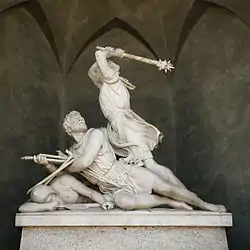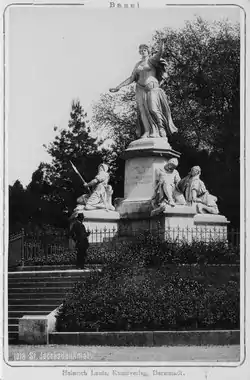Ferdinand Schlöth
Lukas Ferdinand Schlöth (25 January 1818, Basel - 2 August 1891, Lutzenberg) was a Swiss sculptor in the late Classical style.
Life and work
His father, Heinrich Ludwig Schlöth, was a locksmith from Berlin. He completed an apprenticeship with his father as a and was employed in his shop for several years. When his father died, in 1839, he took over the workshop and operated it together with his older brother, Friedrich Ludwig. During this time, he also took drawing lessons from Hieronymus Hess and studied modeling with the sculptor, Johann Heinrich Neustück.
From 1843, he studied sculpture in Rome, where he was influenced by Bertel Thorvaldsen. One of his teachers was probably his fellow Swiss emigrant, Heinrich Maximilian Imhof; with whom he would later develop a hateful rivalry. [1] In 1847, he opened his own studio there. In Rome he experienced financial hardships and he often wasn't able to work due to a lack of Carrara marble.[2] He was living modestly and mainly worked for his clientele from Basel.[2] He remained in Rome until 1874, when he married the wealthy widow, Emma Müller-Gengenbach, and returned to Switzerland. There he divided his time between Basel and Lutzenberg. In Lutzenberg, the family owned an estate, which was brought into the marriage by his wife.[3]
In 1855, he won a competition for a monument honoring Arnold von Winkelried, to be erected in Stans. It was inaugurated in 1865, and immediately made him one of the most prominent Swiss sculptors.[4] This was followed by a monument commemorating the Battle of St. Jakob an der Birs, which was completed in 1872.[5][6] The following year, he won another competition, for a monument honoring Wilhelm von Tegetthoff in Vienna, but the project never came to fruition. He also created a series of busts for the Kunstmuseum Basel. Most of his works are made of white Carrara marble.
In addition to his sculpting, he took some students; notably Richard Kissling. In Rome, he influenced the young Reinhold Begas. Among his later pupils was his nephew, Achilles Schlöth. In Ferdinand Schlöths last will, Achilles was mentioned as the sole heir of his sculpture workshop.[3]
References
- Stefan Hess, Tomas Lochman (Eds.): Klassische Schönheit und vaterländisches Heldentum. Der Basler Bildhauer Ferdinand Schlöth (1818–1891). Basel 2004, ISBN 3-905057-20-4.
- Stefan Hess, Tomas Lochman (Eds.), p.19
- Stefan Hess, Tomas Lochman (Eds.), p.21
- Hess, Stefan (2004). Der Basler Bildhauer Ferdinand Schlöth (1818-1891) : klassische Schönheit und vaterländisches Heldentum (in German). Skulpturhalle Basel. p. 55. ISBN 3-905057-20-4.
- Altbasel. "St. Jakobs Denkmal".
- Basler Bauten. "St. Jakobsdenkmal".
Further reading
- Stephan E. Hauser: Schlöth, Lukas Ferdinand. In: Biografisches Lexikon der Schweizer Kunst. Vol.2 Zürich 1998, pgs. 940 f.
- Stefan Hess: Zwischen Winckelmann und Winkelried. Der Basler Bildhauer Ferdinand Schlöth (1818–1891). Berlin 2010, ISBN 978-3-86805-954-0.
- Tomas Lochman: Antiche sculture nell'opera dell'artista svizzero Ferdinand Schlöth (1818–1891). In: Gli ateliers degli scultori. Atti del secondo convegno internazionale sulle gipsoteche. Fondazione Canova, Possagno. A cura di Mario Guderzo, Terra Ferma 2010, ISBN 978-88-6322-073-5, pgs. 145–156.
- Brigitte Meles: Das St. Jakobs-Denkmal von Ferdinand Schlöth. In: Werner Geiser (Ed.): Ereignis – Mythos – Deutung, 1444–1994 St. Jakob an der Birs. Basel 1994, pgs.140–164.
- Otto Waser: Schlöth, Lukas Ferdinand. In: Schweizerisches Künstler-Lexikon. Redigiert von Carl Brun, Vol. 3. Frauenfeld 1913, pgs. 57–62.
External links
| Wikimedia Commons has media related to Ferdinand Schlöth. |
- Schlöth, Lukas Ferdinand in German, French and Italian in the online Historical Dictionary of Switzerland.
- "Schlöth, Ferdinand". SIKART Lexicon on art in Switzerland., with self-portrait bust.
- Literature by and about Ferdinand Schlöth in the German National Library catalogue
- Works in the Kunstmuseum Basel

